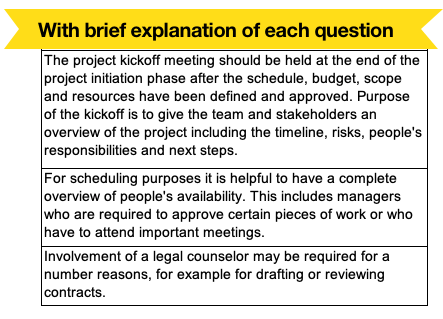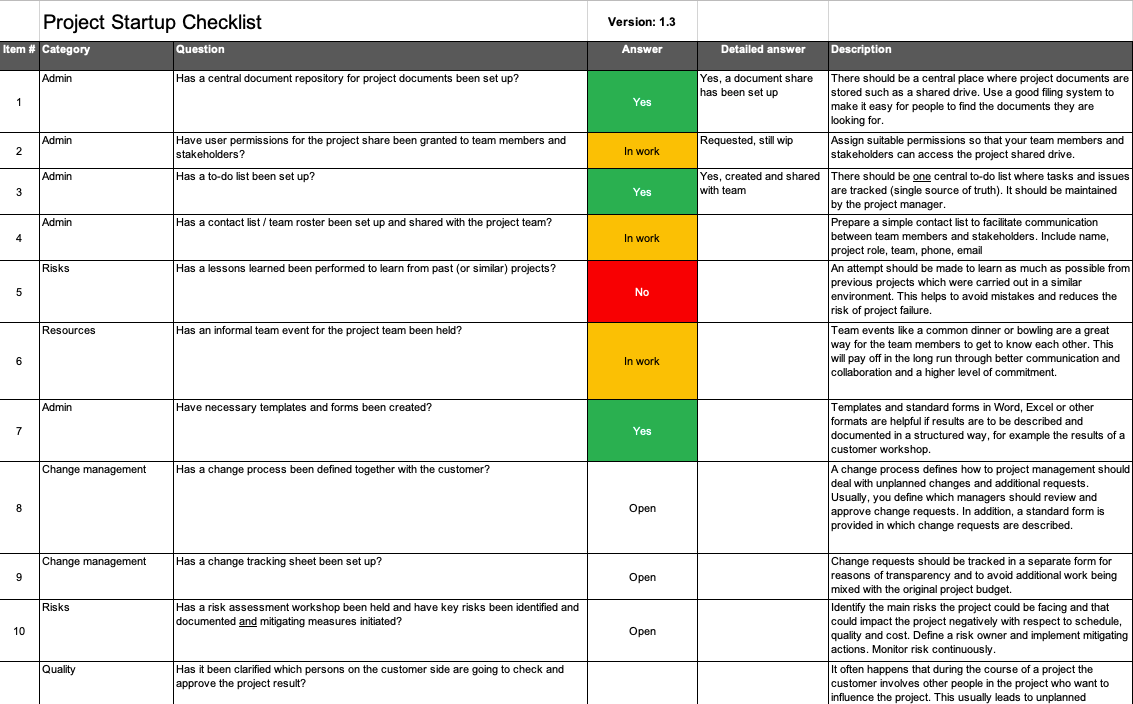
Having just been assigned your first major project, a lot of thoughts might be going through your head:
“I’m all over the place at the moment, not even sure where to start!”
“I don’t know if I’m doing it right or not. I have nothing to gauge it by. I feel unsure about it all.”
“I don’t want to disappoint anyone”
I understand you are worried.
You don’t want to mess up your project so that it’s going to hang around your neck for the rest of your life.
It’s absolutely normal.
You should be worried because the early steps matter.
In fact:
The Truth Is: You Can “make or break” Your Project In The First Few Weeks
Many people in fact waste a lot of valuable time at the start.
They don’t know how to approach their project and so they just fill their time with nonsense work. For example:
- Creating complex Excel templates (when you can find great templates on the web)
- Polishing their Powerpoint deck (but great styling can’t make up for poor content)
- Trying to use a complicated project management software (even though you don’t need one if you are not leading a 10 million dollar project)
These people feel guilty for not having a plan yet, but a look at the calendar gives them comfort:
“I still have 8 weeks to prepare. That should be enough”
After another month wasting time on “fake work” they eventually get nervous, cold sweat on their body.
“Only four more weeks?!? Damn! I have to do get ready NOW ….”
They cobble together something that looks like a project plan (but they know it’s not gonna work).
They hastily organize a workshops with the client.
They invite for a last minute project kickoff.
NOTHING IS DONE RIGHT.
Then two months into the project, the first cracks start to emerge.
Every day there’s another escalation meeting, and the project manager has to face a few tough questions:
- “Did you talk to the client about what the really need? I got an email saying we completely missed their requirements.”
- “[DEPARTMENT] says you didn’t talk to them about the project. Now they are pissed and it seems they are booked out til end of May.”
- “John told me he’s not going to do [TASK] because it’s not his responsibility. Didn’t you hire him for this job?”
- “We haven’t even started work and you’re already asking for additional budget?!?”
That’s the bad news. The Good News Is: You Can Avoid ALL Of That.
You see, each project that you start is “made or broken” in the planning phase — the first few weeks of the project.
There are a couple of steps which are so important that they ABSOLUTELY MUST NOT BE SKIPPED.
For example, sitting down with the client for personal interview to clarify the exact requirements and needs.
Creating a project project plan which is aligned with ALL involved parties.
Or having 1:1 meetings with each team member where you share your expectations.
These are the steps that determine the course of your project.
Get the planning phase wrong, AND THE WEIGHT OF FAILURE IS GOING TO HANG AROUND YOUR NECK
- Your project is going to be late
- Your customer is going to be mad at you for not keeping your promise
- Your track record is going to be tainted with a failed project (that everybody in the organization will know about)
Get the planning phase right, and ride on a wave of success
- You won’t have to worry anymore. Sure, there will be hiccups and problems along the way, but you’ll be able to stay on course because your project is built on solid ground.
- You’ll be your promise and deliver the project or product in time and in budget
- Your executives will pat you on the back: “Well done!”
- You’ll be extremely proud of yourself (and you’ll look at life much differently having mastered the challenge)
So, how can you get the planning phase right and use the time wisely?
A simple checklist can take you through the planning phase
To make sure you set up your project in the right way, you don’t want to rely on how you are feeling today or what you enjoy and don’t enjoy doing.
Instead, you want to have a bullet-proof system you can just follow step by step.
This way…
- you’ll exactly know what to do today, tomorrow, next week etc.
- you’ll know that the important steps will get done no matter what
- you don’t have to worry about wasting time
- You can be certain you haven’t overlooked any important step
And what’s best:
With a checklist to guide you, your project is going to move forward every day 🙂
If you have a checklist which gives you the steps to set up your project, you’ll always be in control of things and you’ll be able to enjoy your work.
The best companies always use checklists for their projects. They can’t afford to let their projects fail.
And I think everybody who manages a project should follow a checklist. Why should you leave a project’s success to chance?
For this reason I created a Project Startup Checklist.
I’ve always used it in my projects, which were large IT system implementations. It was a massive help because it helped me move from “thinking mode” to “action mode”.
And today I’m sharing my checklist with you.
Introducing The Tactical Project Manager Project Startup Checklist
43 questions you need to ask yourself at the start of any project
(so you can be sure your project is going to be fine)
In the project checklist, you’ll find 43 questions in the form “Have you done x?”, where x are all the steps you need to take to set up your project properly.
The questions cover all critical areas for projects, including the planning aspect, scope, availability of resources, risk management, communication and more.
With the project checklist you’ll be able to:
- get your project set up fast without compromising quality
- focus your energy on topics that really matter
- track your progress (and keep yourself accountable)
- plan your work
A sneak peek into the project startup checklist
Here’s a quick preview (click on the image to see a part of the content):
Questions are arranged in the typical order of a project.
Here’s an example:

Another example. Note that we are emphasizing the client should be interviewed personally.

And for every checklist item you’ll find a brief explanation:

About me
 Hi there, I’m Adrian Neumeyer, former IT project manager with 10 years of experience. Today I run Tactical Project Manager to give people like you the best knowledge and tools for managing even the toughest projects with success.
Hi there, I’m Adrian Neumeyer, former IT project manager with 10 years of experience. Today I run Tactical Project Manager to give people like you the best knowledge and tools for managing even the toughest projects with success. Who is is the checklist for?
Case 1: You are a project manager
You want to be more systematic, build your confidence as a PM and learn best practices. You’ve understood that in order to do a good job, you shouldn’t take the path of least resistance but instead do what needs to be done. The checklist tells you what you need to do.
Case 2: You are a manager or director overseeing a project portfolio
You are responsible for a large portfolio of projects, but you’re not happy with the results. You’re spending too much time in escalation meetings or discussions with your clients. Projects are often running late and you feel stupid asking for more budget all the time.
You want to make sure your project leaders follow basic practices so that projects always stay within schedule and budget.
Give my checklist to your project managers, so they have a proven formula they can follow for setting up their projects. The checklist is a highly practical and easy-to-use tool. It will help even less junior-level PMs.
The checklist has been designed in a way that it’ll work for any project. It covers the general steps that should always be taken for new projects, no matter what industry you’re in. We recommend that you add questions relevant to your field of work.
No Risk For You: 30-day Money Back Guarantee
If you don’t find the checklist helpful, I’ll refund you the money within 30 days after your purchase.

Get The Project Startup Checklist (for Excel)
You will get an automatic email with a download link.
